If you pay attention to Japanese conversation, you can find numerous “hai” in just 5 minutes of conversation. As you may already know, はい “hai” is an expression that can be used to bring agreement to almost anything.
But this magic word has more than one function that can be used everywhere in everyday life. In this article I will show you the pronunciation, the five functions of “hai” and of course with examples to make sure you know how to use “hai” properly!
In addition, if you are currently learning phrases or sentences that are very common in everyday Japanese conversation, please also read our recommendations below:
Read also:
The Most Valuable Things to Know about “Wakaranai (分からない)”
What does “Kabedon (壁ドン)” Mean in Japanese?
The Meaning of Yabai (やばい)
Contents
5 Functions of はい (Hai) in Japanese with Examples
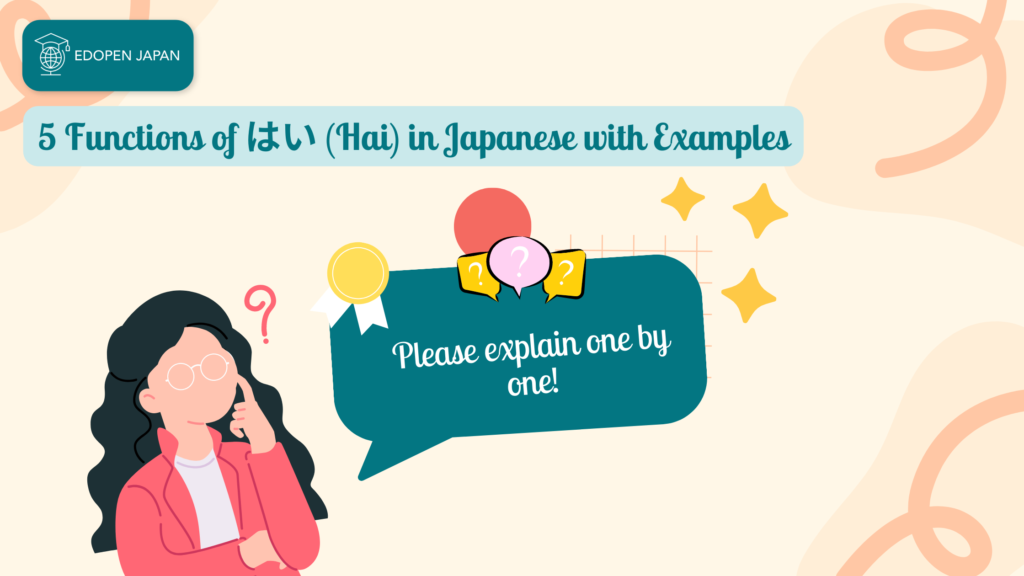
① To make agreement / affirmative response
This is one of the most common meanings of はい used in everyday life. This can be easily translated to “YES” in English. However, at the same time, “hai” can also be translated as “NO” in English. Sounds complicated, right?
First, let’s take a look at how to use はい “hai” to make an affirmative response as “yes.
| 潤: 健さん、普段運動しますか? Ken, do you usually do excise? 健: はい、週に2回ジムに通います。 Yes, I go to the gym twice a week. |
| Q: Excuse me, are you the teacher at this university. A: Yes, do you need any help? |
💡 While “hai” means yes in English, the antonym which means no in Japanese is いいえ”iie”.
はい can also be translated into “no” in English
In proper English grammar, if you are asked a negative question like the one below.
| 昨日健と会いませんでしたか? Didn’t you meet Ken yesterday? |
For this negative question, a “no” answer in English often means that “the person being asked did not meet Ken yesterday”. Likewise, a “yes” would mean that “the person being asked met Ken yesterday.“
In Japanese, however, the opposite is true. A はい “hai” in Japanese means that the person being asked hasn’t met Ken. On the other hand, いいえ “iie” would mean “the person being asked met Ken yesterday”.
| Japanese | はい、昨日健と会いませんでした。 | いいえ、昨日健と会いました。 |
| English | No, I didn’t meet Ken yesterday. | Yes, I met Ken yesterday. |
How does it work? In Japanese, answering with “hai” is the agreement / affirmative answer to the whole question, no matter if there is a negative question or a positive question. In other words, if you agree with what the other person said, you can always say はい”hai”.
The other example to deepen your understanding about “hai”
💡 Here is another example for practice again. What is your answer to 『 この映画を見たことありません “I have never seen this movie before“』 in Japanese? はい “hai”? いいえ “iie”?
| この映画を見たことない? Haven’t you watched this movie before? |
If you agree with the question, which means that you agree that you haven’t seen the movie yet, then the answer would be: はい、この映画を見たことありません。
To avoid the potential misunderstanding, native English speakers often answer with a clarification/explanation after a yes or no. Or, sometimes, people answer by omitting the yes and no and simply giving the answer with a clarification/explanation.
Just like in English, this kind of misunderstanding sometimes happens in Japanese. It is also suggested to give an explanation to make the conversation better!
Similar Expression in Japanese
| そう / そうです / そうですね | sō / sō-de-su / sō-de-su-ne | Yes / That’s right |
| うん | un | Yes (a less formal expression) |
② To Mean “Understood”, “Okay”, “Got it”
“Hai” can be widely used here to give an answer when you are asked to do something, whether in casual situations, at school, or at work.
Although it is not a problem to just say “hai” to mean “I got it,” there are many phrases that people say after “hai. Among all these sentences, although the meanings are quite similar, these sentences differ in the degree of formality. Below are the examples listed from casual to formal.
| はい、分かりました。 | wa-ka-ri-ma-shi-ta |
| はい、了解しました。 | ryō-kai-shi-ma-shi-ta |
| はい、承知しました。 | shō-chi-shi-ma-shi-ta. |
Also, when using “hai,” be sure to respond with the appropriate tone. If you sound impatient or reluctant, it may give others a bad impression that you are unwilling to accept or do something. In this case, for example, if you are facing your professor, supervisor, customer, or any occasion where you want to show your politeness, make sure you answer with an energetic はい “hai!
はい、はい、はい、、、(Hai, Hai, Hai…)
Have you ever been in this situation? You are sitting in your messy room playing video games or surfing the Internet with a lot of homework to do. Your parents keep telling you to do this and that. This may be repeated day after day. Or your friend keeps telling you a story you have heard a thousand times.
With “hai, hai, hai” you are sending messages like “okay, okay, you told me that a hundred times already”. Of course, this is recommended when you are talking to your close family or friends!
③ Excuse me? What did you say?
This use of “hai” works as a question. In this case, you can find the rising intonation at the end.
- When you can’t hear/understand clearly what others are saying.
| はい?もう一度お願いしでもいいですか? | ha-i? mo-u-ichi-do-o-nega-i-shi-de-mo-i-i-de-su-ka? | Sorry? Can you repeat it one more time? |
- When you find what others say offensive or something you don’t agree with. With “hai” it means that you question others.
④ “Hai” before an action to indicate a timing
Most of the time people say “hai” when they start doing something.
| はい、チーズ。 | ha-i, chī-zu | Say cheese. |
| はい、行きましょう! | ha-i, i-ki-ma-sho-u | Let’s go! |
| はい、食べよ。 | ha-i, ta-be-yo | Let’s eat. |
| はい、どうぞ。 | ha-i, dō-zo | Here you go. |
⑤ “I am listening.”
When someone is talking to you, you can say “hai” while the person has made a short pause or told you an important thing to let the other side know that you are paying attention to the conversation. In this case, the person who is talking can also make sure that you can understand the content or not.
When talking face to face, instead of saying “hai,” people can nod to show they are listening. But when we talk on the phone, we can’t see each other. In this case, “hai” plays a very important role during a phone call.
What is the difference between ええ (ee) & はい (hai) in Japanese?

In terms of meaning, both はい (hi) and ええ (ee) have the same meaning, which is “yes”. However, “hi” is said to be more formal, while “ee” is used more in casual, everyday conversation that is not formal, more relaxed.
Besides “ee”, there is also the expression うん (un), which is usually followed by a nod, うん (un) also means “yes”. However, “un” is only commonly used in very casual everyday speech. That is, the expression “un” is only polite to use with close friends or family.
FAQ about はい (Hai) in Japanese
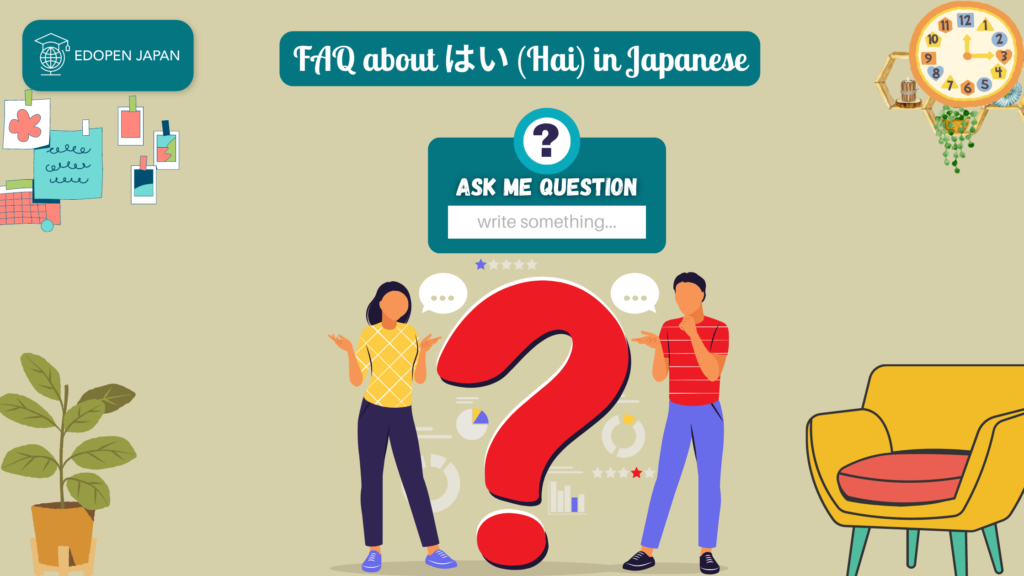
Here is an example of frequently asked questions about this very popular expression はい (hai) in Japanese!
What is your opinion? Do you have any other questions about the term はい (hi)? Or do you have experience with this term? Please share it in the comments section below!
Summary
はい、これは”はい”についての説明です。何か質問がありますか?This is the explanation about “hai”. Do you have any questions? And the following are some key points from this article:
- “Hai/Yes” in Japanese can be used when you give an affirmative answer. The phrase “Hai/Yes” works as an answer when you are asked to do something.
- Use this phrase when you want others to repeat what they said one more time. Use it when you start to do something as well.
- You can use はい (hai) to let others know that you are also listening. However, please be careful with your tone. Please note also that, an energetic “hai” can leave a good impression on others. However, a tired, impatient, reluctant tone can convey a completely different message!

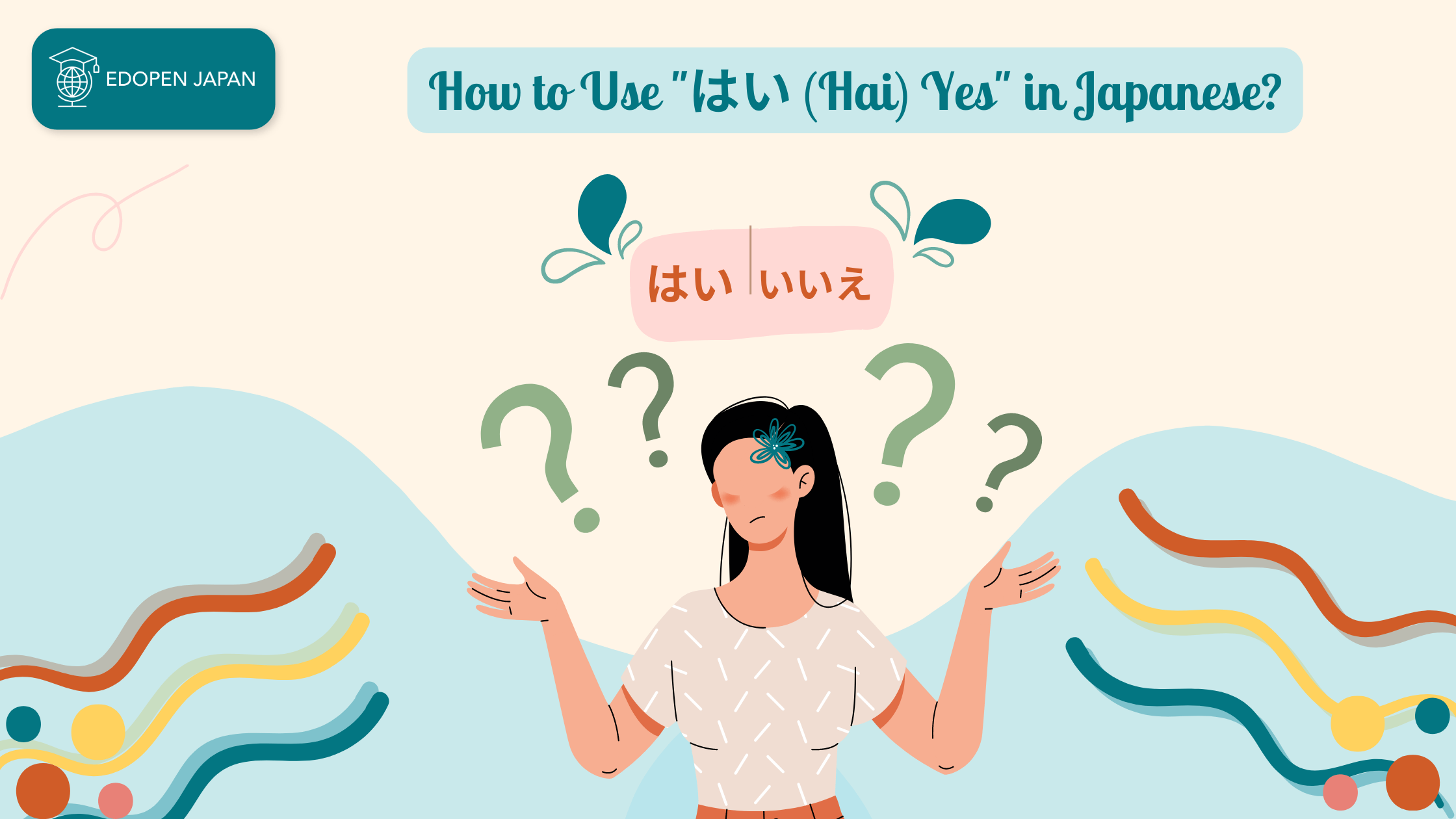
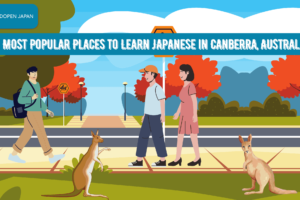

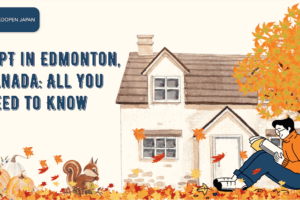









Leave a Reply